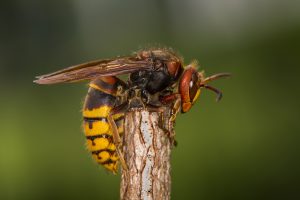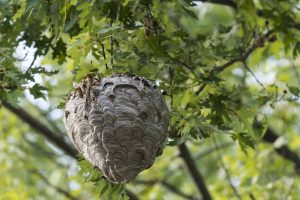How To Identify Hornet Nests
Hornets are skilled builders and adapt to various nesting locations, including cracks in your home, open spaces, and even underground. Unlike wasps or bees, these insects don’t build their nests in hidden burrows. Instead, they prefer trees, shrubs, or sheltered areas like eaves or wall voids.
Hornets and wasps are often mistaken for one another, but recognizing the differences between these two insects is important. You can better understand hornet nesting habits and behaviors by learning to tell the two apart.
Identifying their nests can make all the difference in safety, as hornets can become aggressive when their nests are disturbed. Learn more about the dangers hornets can pose.
Most Common Type of Hornet Nest
In Georgia, two types of hornet nests are most frequently encountered: European and bald-faced. Each has unique characteristics that can help with identification.
European Hornet Nests
 These large, papery nests are often built in sheltered areas such as wall voids, attics, or hollow trees. European hornets prefer enclosed spaces, and their nests can grow to house hundreds of workers. They’re usually enclosed and hidden in protected spaces such as hollow trees or wall voids.
These large, papery nests are often built in sheltered areas such as wall voids, attics, or hollow trees. European hornets prefer enclosed spaces, and their nests can grow to house hundreds of workers. They’re usually enclosed and hidden in protected spaces such as hollow trees or wall voids.
Due to the paper-like material, primarily made up of wood-fibers, their nests have a smooth, layered appearance.
Bald-Faced Hornet Nests
 These nests are typically constructed in open spaces like tree branches, shrubs, or building overhangs. Bald-faced hornet nests are spherical, made from a gray, paper-like material, and can be up to 24 inches in diameter. They’re often found hanging from tree branches or roof edges.
These nests are typically constructed in open spaces like tree branches, shrubs, or building overhangs. Bald-faced hornet nests are spherical, made from a gray, paper-like material, and can be up to 24 inches in diameter. They’re often found hanging from tree branches or roof edges.
These nests are easy to spot in exposed locations but best left undisturbed.
Preventing hornets from infesting your outdoor space is essential for avoiding nests and ensuring a safe environment. Discover ways to keep hornets away (and avoid getting stung in the process!).
Where Are Hornet Nests Found?
Hornets choose nesting locations based on their species and environmental preferences. Their adaptability allows them to construct nests in a variety of spaces, including those near human activity. Here are some common locations where hornet nests may be found:
- Wall Voids: Hornets, especially European hornets, often nest in wall cavities or other hollow spaces within homes or outbuildings.
- Sheltered Areas: Bald-faced hornets frequently build nests under roof eaves, in sheds, or on porches.
- Hollow Trees: Trees with natural cavities are prime nesting spots for hornets.
- Ground Nests: While less common for hornets, some species occasionally nest close to or within the ground.
- Exposed Locations: Open spaces such as tree branches or large shrubs are popular for visible, hanging nests.
The nesting location often provides clues about the type of hornet present, helping homeowners decide the next steps.
Our hornet nest experts can help you identify the hornet species based on their nest and recommend the safest removal plan. Discover more about our nest removal services today!
Need Help With Hornet Nest Removal?
Discovering a hornet nest on your property can be alarming. Don’t take risks by attempting to remove it yourself; our team of experts handle the hard part for you. Get a FREE quote from Active Pest Control today.
FAQs
What is the difference between a hornet nest and a wasp nest?
Hornet nests are typically larger, spherical, and made of a gray, paper-like material. They are often found in trees or roof eaves. Wasp nests vary in shape, size, and material, depending on the species. They can be open hexagonal cells, combs, or enclosed.
Both serve as homes for their colonies.
How long will a hornet’s nest last?
A hornet’s nest typically lasts one season. It starts in spring when the queen builds the nest, and the colony grows through summer. Once winter arrives, the colony dies off, and the nest is abandoned, as hornets rarely reuse old nests.
Should I be worried about a hornet’s nest?
Yes, if a hornet’s nest is close to human activity, it can pose a risk, as hornets are defensive and can sting multiple times. Keeping your distance and contacting a professional for safe removal is the best approach.
Should I destroy a hornet’s nest?
No, destroying a hornet’s nest on your own can provoke the hornets, leading to stings and injuries. It’s safer to contact a pest control professional with the expertise and tools to handle the situation effectively and safely.
Should I just leave a hornet’s nest alone?
If the nest is remote and poses no threat, you may leave it alone, as the colony will die off in winter. However, pest control professionals should handle nests near homes or frequented areas.
